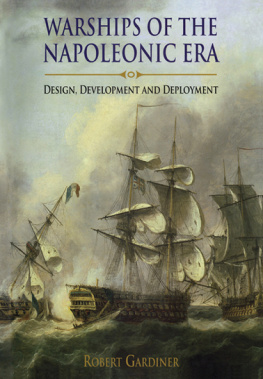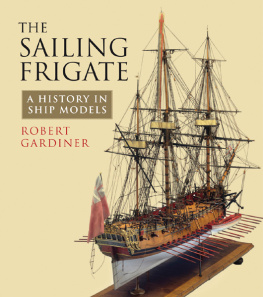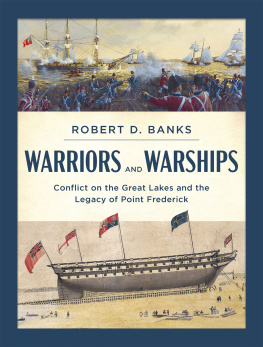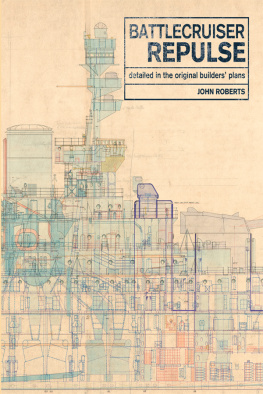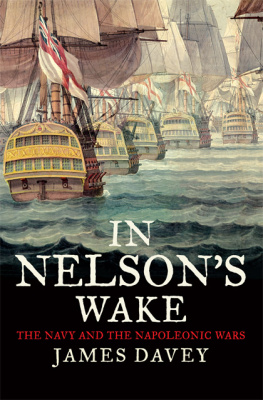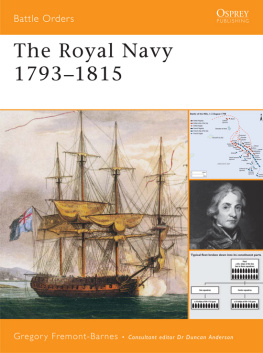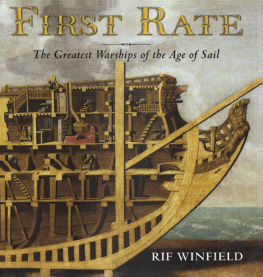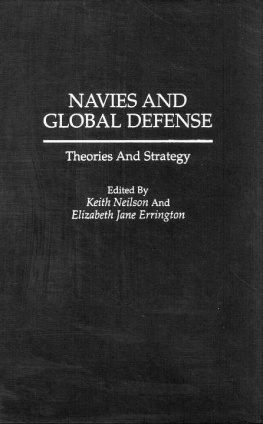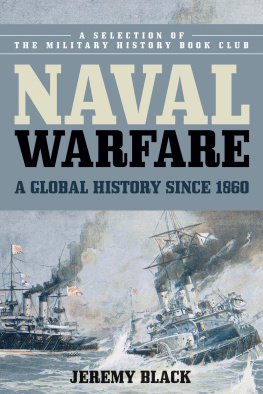WARSHIPS OF THE
NAPOLEONIC ERA
DESIGN, DEVELOPMENT AND DEPLOYMENT
ROBERT GARDINER
T HE classic British frigate portrayed in an accurate and detailed lithograph by Thomas Dutton: the Leda class frigate Pomone of 1805, built alongside her more famous sister HMS Shannon in the Frindsbury shipyard of Josiah & Thomas Brindley on the river Medway (NEG 5666)
N ICHOLAS POCOCKS panorama of Nelsons fleet attacking Copenhagen in 1801. The city is in the distance to the right, with a line of Danish blockships and batteries defending it from the two-deckers of the British squadron. In the left foreground is a row of bomb vessels, lobbing their shells over both lines of ships, and to the right, in action with the Trekroner fort, part of the frigate squadron, including the recognisably pointed sterns of the sloops Dart and Arrow. Despite compression of the perspective, the view is remarkably accurate in the disposition and types of the ships involved. (BHC0529)
Robert Gardiner 1999 & 2011
This edition first published in Great Britain in 2011 by
Seaforth Publishing
An imprint of Pen & Sword Books Ltd
47 Church Street, Barnsley
S Yorkshire S70 2AS
www.seaforthpublishing.com
Email info@seaforthpublishing.com
British Library Cataloguing in Publication Data
A CIP data record for this book is available from the British Library
ISBN 978 1 84832 108 3
All rights reserved. No part of this publication may be reproduced or transmitted in any form or by any means, electronic or mechanical, including photocopying, recording, or any information storage and retrieval system, without prior permission in writing of both the copyright owner and the above publisher.
The right of Robert Gardiner to be identified as the author of this work has been asserted in accordance with the Copyright, Designs and Patents Act 1988
Typeset and designed by Roger Daniels
Printed in China by 1010 Printing International Ltd
CONTENTS
Warships of the Napoleonic Era was first published in 1999 and the text remains essentially unchanged, although there is some additional information on selected themes, as well as the inevitable qualifications and corrections brought about by a decade of further research. What is new in this edition is mainly to be found in the illustrations most are reproduced in colour for the first time and on a larger page size, which makes the ship draughts far more comprehensible. These plans remain the core of the illustrative material, but there are also a selection of ship models, paintings and contemporary prints, chosen to back specific points in the text.
THE DRAUGHTS
The National Maritime Museum at Greenwich houses the largest collection of original ship plans in the world. The Admiralty collections alone are an almost unbroken technical and historical record dating back to about 1700. However, for the age of sail it has some limitations in the kind of draughts it preserves. The collection is derived from the Navy Boards central record, which are mainly the design plans produced ahead of construction; a short-lived policy of ordering as fitted draughts in the 1770s seems to have collapsed under the weight of work brought on by the American Revolutionary War. As a result, the plans show only what was unique to that design: the hull form, the general arrangement and the basic layout of fittings. Much of the construction, and certainly the fitting out, was governed by standard practice, in earlier years known as establishments. Thus there are few rigging, or even spar, plans; very little illustration of armament; and only the vaguest indication of decorative work.
From other sources if is known that separate plans were prepared for many aspects of design and construction, but most were regarded as ephemeral and only survive in small numbers, often outside mainstream collections. The usual Admiralty draughts comprise: an external elevation, or sheer plan, in three views (side, half-breadth, and body plan); there may be a separate profile showing interior works, but this was often combined in a second colour (red) with the external sheer; deck plans, often one for each level, although small craft may include them all on one sheet; and, as construction became more individual, a disposition of frame. Alterations and additions were often marked on the master draught in green ink, which is a major argument for reproduction in full colour.
Since this book is mainly concerned with the generalities of ship design and function, most of the draughts chosen arc sheer or sheer/profile plans, intended to convey the basic characteristics of the ships for easy comparison.
ACKNOWLEDGEMENTS
All but a handful of images in this book come from the collections of the National Maritime Museum at Greenwich, and the book would have been impossible without the enthusiastic cooperation of Douglas McCarthy, Rights & Images Manager of their Picture Library. The debts acknowledged in the original edition still apply, but the author would like to add Jeremy Michell and the present staff of the Brass Foundry at Woolwich, whose helpfulness and hospitality carries on the long and honourable tradition of their institution.
Outside the NMM, we must thank Major Grant Walker of the US Naval Academy Museum and Arnold and Henry Kriegstein for permission to use photos of models in their care.
Modern warship types are usually defined by their function. There is no doubt about the role of an aircraft carrier, minesweeper, or ballistic missile submarine, but in the age of sail it was not so simple. Admittedly, there were specialist types like bomb vessels and fireships, and the line of battle ships from which the modern term battleship derived were differentiated from frigates and other craft which operated outside the battle line. However, the usual type description was a rating and the number of guns carried a 98-gun Second Rate, lor example. To the modern reader, these divisions seem arbitrary and illogical why build a 98-gun ship as well as one of 100 guns? but the rating system often masks quite distinct ship types with their own definable role. The purpose of this book is to illustrate each of the main types, mainly with original draughts, and to provide a commentary pointing out what each class was for, and how they were actually employed during the French Revolutionary and Napoleonic Wars. Of course, some of the ship types can only be explained as a result of developments pre-dating 1793, so some potted design histories are included as well.
In the sections which follow, the descriptions of the function of each type are necessarily generalisations, based on analyses of Admiralty station lists,1 and the operations in which ships were most commonly involved. It should not be necessary to point out that the exigencies of war inevitably lead to the unsuitable employment of many ships simply because they were the only ones available, but the existence of exceptions need not invalidate the overall conclusions. Strategic emergencies like the invasion threats of 1801 or 18035 often overrode normal concepts of the employment of certain ship types, but conversely the consistency of Britains long-term interests always meant that the Channel and Mediterranean Fleets would have first priority: the best (which at this time was usually synonymous with largest) and newest vessels in almost every class would gravitate to these commands. Since the ship itself was only one part of the weapon system, individual vessels might be chosen for specific duties because of the known efficiency of the crew, and the reputation of the officers, but the best captains often got the best ships in any case. In his memoirs Captain Philip Durham, an officer with both ability and interest, claimed, Ships to me are like hackney coaches, so I will take the first off the stand; he was trying to point out how different was his attitude from that of most officers, but it was a disingenuous claim from a man who contrived to command some of the finest ships in the Royal Navy the big frigates

